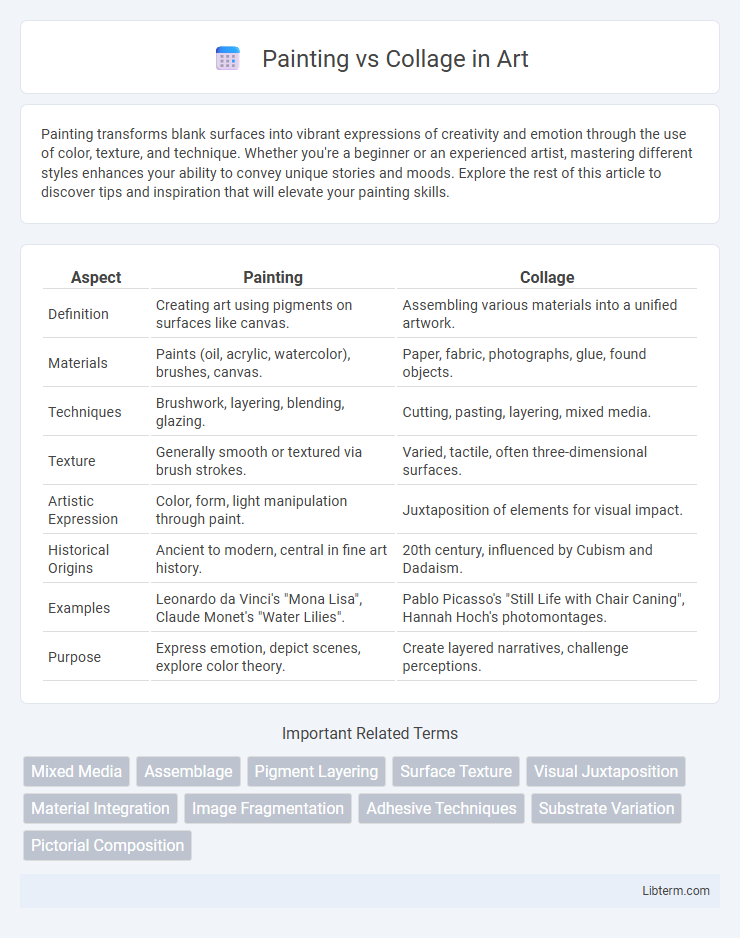Painting transforms blank surfaces into vibrant expressions of creativity and emotion through the use of color, texture, and technique. Whether you're a beginner or an experienced artist, mastering different styles enhances your ability to convey unique stories and moods. Explore the rest of this article to discover tips and inspiration that will elevate your painting skills.
Table of Comparison
| Aspect | Painting | Collage |
|---|---|---|
| Definition | Creating art using pigments on surfaces like canvas. | Assembling various materials into a unified artwork. |
| Materials | Paints (oil, acrylic, watercolor), brushes, canvas. | Paper, fabric, photographs, glue, found objects. |
| Techniques | Brushwork, layering, blending, glazing. | Cutting, pasting, layering, mixed media. |
| Texture | Generally smooth or textured via brush strokes. | Varied, tactile, often three-dimensional surfaces. |
| Artistic Expression | Color, form, light manipulation through paint. | Juxtaposition of elements for visual impact. |
| Historical Origins | Ancient to modern, central in fine art history. | 20th century, influenced by Cubism and Dadaism. |
| Examples | Leonardo da Vinci's "Mona Lisa", Claude Monet's "Water Lilies". | Pablo Picasso's "Still Life with Chair Caning", Hannah Hoch's photomontages. |
| Purpose | Express emotion, depict scenes, explore color theory. | Create layered narratives, challenge perceptions. |
Introduction to Painting and Collage
Painting involves applying pigments to a surface using tools such as brushes, knives, or sponges, emphasizing color, texture, and form to create a cohesive visual expression. Collage is a technique that assembles various materials like paper, fabric, and photographs onto a substrate, layering disparate elements to construct new meanings and textures. Both practices serve as foundational methods in visual arts, offering distinct approaches to creativity and storytelling through composition and material interaction.
Defining Painting: Techniques and Mediums
Painting involves applying pigments to surfaces such as canvas, wood, or paper using techniques like brushwork, glazing, and impasto to create texture and depth. Common mediums include oil, acrylic, watercolor, and tempera, each offering distinct drying times, finishes, and color vibrancy. Mastery of these techniques and mediums enables artists to express a wide range of styles, from realism to abstract, through controlled manipulation of light, color, and form.
Collage Art: Origins and Principles
Collage art originated in the early 20th century with artists like Pablo Picasso and Georges Braque, who integrated paper, fabric, and found objects into their paintings, pioneering Cubism. This art form is based on layering diverse materials such as photographs, newspaper clippings, and textured papers to create a unified composition emphasizing contrast, texture, and visual storytelling. Collage challenges traditional art principles by blending disparate elements, encouraging creativity through fragmentation and synthesis.
Historical Evolution of Painting and Collage
Painting, one of the oldest artistic forms, dates back to prehistoric cave art around 40,000 years ago and evolved through various movements such as Renaissance, Baroque, Impressionism, and Modernism, emphasizing representation and expression. Collage emerged in the early 20th century with Cubism pioneers like Pablo Picasso and Georges Braque, introducing the technique of assembling different materials--paper, fabric, photographs--onto a canvas to challenge traditional painting boundaries. This evolution highlights painting's long-standing tradition of visual storytelling contrasted with collage's innovative approach to juxtaposition and materiality in modern art.
Materials Used in Painting vs Collage
Painting primarily utilizes materials such as oil paints, acrylics, watercolors, and various types of brushes and canvases, enabling artists to create images through pigment application on surfaces like canvas, wood, or paper. In contrast, collage incorporates a diverse range of materials including paper scraps, photographs, fabric, newspaper clippings, and found objects, which are assembled and adhered to a backing to build a composition. While painting relies on fluid mediums and color blending, collage emphasizes texture and layering of tangible materials to achieve depth and contrast.
Creative Processes Compared
Painting relies heavily on brushwork, color blending, and layering techniques to build depth and texture, emphasizing individual expression through fluid manipulation of materials. Collage integrates diverse materials such as paper, fabric, and found objects, creating a multidimensional composition by juxtaposing elements and textures, which encourages an assemblage mindset. Both processes engage creativity but differ in tactility and decision-making, with painting focusing on direct mark-making and collage on combining pre-existing fragments.
Visual Impact and Artistic Expression
Painting offers a rich visual impact through color blending, texture, and brushstroke techniques that create depth and emotional intensity. Collage combines diverse materials and images, generating layered compositions that evoke fragmented narratives and dynamic contrasts. Both mediums provide unique artistic expressions: painting emphasizes fluidity and continuity, while collage explores texture, juxtaposition, and conceptual complexity.
Notable Artists in Painting and Collage
Renowned painters such as Pablo Picasso, Claude Monet, and Frida Kahlo transformed visual art with their mastery of brushstrokes, color theory, and composition. In contrast, collage artists like Henri Matisse, Robert Rauschenberg, and Romare Bearden innovated by assembling diverse materials to create layered, textured narratives. Both mediums have significantly influenced modern and contemporary art by pushing creative boundaries and exploring unique methods of expression.
Advantages and Challenges of Each Medium
Painting offers vivid color blending and texture control, allowing artists to achieve depth and realism, but it requires mastery of techniques and can be time-consuming. Collage enables the integration of diverse materials and found objects for rich visual narratives, promoting creativity through layering, yet it may face challenges in durability and cohesion. Both mediums demand distinct skills and offer unique expressive possibilities, influencing an artist's workflow and conceptual approach.
Choosing the Right Art Form for You
Choosing the right art form between painting and collage depends on your preferred mode of expression and creative process. Painting offers a fluid, color-based medium ideal for exploring texture, light, and brushwork, while collage involves assembling diverse materials to create layered visual narratives. Understanding your artistic goals and comfort with materials can guide you in selecting the medium that best suits your style and vision.
Painting Infographic

 libterm.com
libterm.com